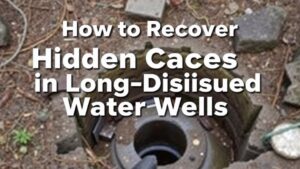Recovering Artifacts From Dried-Up Waterways and Irrigation Channels
Recovering Artifacts From Dried-Up Waterways and Irrigation Channels
The quest to recover artifacts from dried-up waterways and irrigation channels is a significant branch of archaeology and historical preservation. As the water levels in various rivers and lakes recede, they often expose hidden treasures that can provide insights into past civilizations, climate change, and human adaptation. This article explores the methods, challenges, and implications of artifact recovery in these environments.
The Importance of Waterways in Human History
Waterways have historically been vital to human settlement and economic development. serve as transportation routes, sources of irrigation, and centers for trade. Major civilizations, such as those along the Nile, the Indus, and the Yangtze rivers, relied on these waterways for their sustenance and growth. When modern climatic changes lead to the drying up of these waterways, the exposed sediments can reveal invaluable information about past societies.
Methodologies for Artifact Recovery
The recovery of artifacts from dried-up waterways typically involves several systematic approaches, combining both archaeological fieldwork and scientific techniques. Some commonly used methodologies include:
- Site Surveying: Archaeologists conduct initial assessments of exposed riverbeds to identify potential sites through visual inspection and geophysical tools.
- Excavation Techniques: Standard archaeological excavation methods, like stratigraphic digging, are applied to preserve the context of artifacts. Wet screening may also be utilized to recover smaller items.
- Remote Sensing: Technologies such as GIS and aerial photography can help archaeologists locate buried structures or patterns in sediment that may indicate human activity.
For example, in 2021, archaeologists uncovered an ancient Roman city along the banks of the Tiber River in Italy, using such methodologies as the river receded significantly due to drought.
Case Studies of Notable Recoveries
Many remarkable discoveries have been made by recovering artifacts from dried-up waterways. Here are a few noteworthy examples:
- The Worlds Oldest Known Maps: In 2020, a drought in Iraq revealed clay tablets containing some of the earliest maps, dating back to 2,500 BC, in the Tigris-Euphrates river system.
- The Lost Civilizations of the American Southwest: Drought conditions in Lake Mead, Arizona, exposed remnants of ancient Puebloan structures, providing new insights into the social structure of these communities.
- Chinese Artifacts: Recently, exposure of the ancient irrigation channels in China due to extreme drought led to the recovery of pottery and tools that date back over 1,000 years, illustrating advanced agricultural practices.
Challenges in Artifact Recovery
Despite the opportunities presented by low water levels, several challenges complicate the recovery of artifacts:
- Condition of Artifacts: Exposure to air and sunlight can deteriorate organic matter, metals, and fabric. Timely retrieval is critical to preserve these findings.
- Legal and Cultural Issues: The recovery of artifacts can become a legal quagmire regarding ownership, especially when cultural heritage is involved. Engaging with local communities and authorities is essential to navigate these complexities.
- Environmental Concerns: Disturbing sensitive ecological areas can lead to further ecological degradation, necessitating a balance between archaeological practices and environmental stewardship.
Implications for Future Research
The recovery of artifacts from dried-up waterways holds profound implications for archaeology, anthropology, and history. By examining these finds, researchers can gain insights into:
- Cultural Exchange: Artifacts often reveal trade routes and cultural interactions, enriching our understanding of historical societies.
- Climate Resilience: Understanding how past civilizations adapted to climatic shifts can inform current approaches to sustainability and resilience.
- Preservation Techniques: Developing better methods for artifact retrieval and preservation will continue to be a critical area of research.
Actionable Takeaways
For researchers and enthusiasts looking to engage in the recovery of artifacts from dried-up waterways and irrigation channels, consider the following:
- Stay informed about local regulations and engage with community stakeholders in artifact recovery efforts.
- Use a multidisciplinary approach, combining archaeology with environmental science, history, and technology.
- Prioritize the preservation of artifacts and their context to ensure the integrity of historical findings.
To wrap up, the exploration of dried-up waterways for artifacts is an increasingly fruitful area of study that enriches our understanding of human history. Despite the challenges involved, the potential discoveries can significantly contribute to various academic fields, offering a glimpse into the past and insights for the future.



